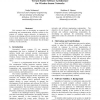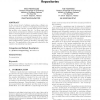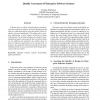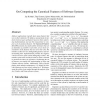VISSOFT
2005
IEEE
14 years 6 months ago
2005
IEEE
The clear and meaningful visualization of relations between software entities is an invaluable tool for the comprehension, evaluation, and reengineering of the structure of existi...
ICSM
2005
IEEE
14 years 6 months ago
2005
IEEE
In the context of software maintenance, legacy software systems are continuously re-engineered in order to correct errors, provide new functionality, or port them into modern plat...
ICSM
2005
IEEE
14 years 6 months ago
2005
IEEE
Clustering layouts of software systems combine two important aspects: they reveal groups of related artifacts of the software system, and they produce a visualization of the resul...
DATE
2005
IEEE
14 years 6 months ago
2005
IEEE
The design productivity gap requires more efficient design methods. Software systems have faced the same challenge and seem to have mastered it with the
COMPSAC
2005
IEEE
14 years 6 months ago
2005
IEEE
This research aims at developing an approach for architecting and communicating software systems in the context of wireless sensor networks. In particular, it focuses on developin...
MSR
2006
ACM
14 years 6 months ago
2006
ACM
In the current trend of software engineering, software systems are viewed as clusters of overlapping structures representing various concerns, covering heterogeneous artifacts lik...
ISSTA
2006
ACM
14 years 6 months ago
2006
ACM
In a component-based software system the components are specified, designed and implemented with the intention to be reused, and are assembled in various contexts in order to pro...
WCRE
2006
IEEE
14 years 6 months ago
2006
IEEE
The understanding of the structure of a software system can be improved by analyzing the system’s evolution during development. Visualizations of software history that provide o...
WCRE
2006
IEEE
14 years 6 months ago
2006
IEEE
In the last years, as object-oriented software systems became more and more complex, the need of having tools that help us to understand and to assess the quality of their design ...
WCRE
2006
IEEE
14 years 6 months ago
2006
IEEE
Software applications typically have many features that vary in their similarity. We define a measurement of similarity between pairs of features based on their underlying implem...




